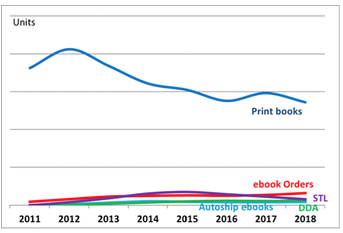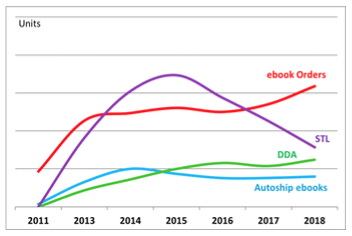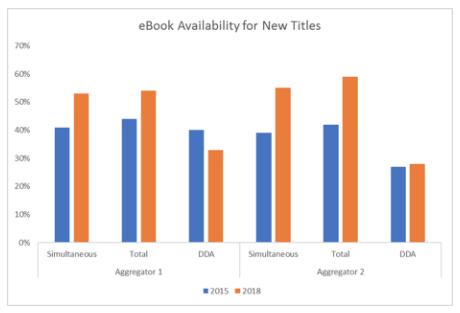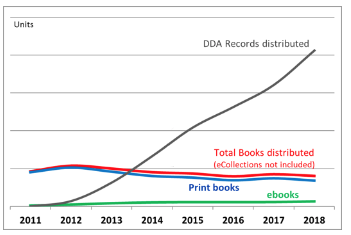Case Study: DDA (Demand-Driven Acquisition of Monographs)
Executive Summary
Demand-Driven Acquisition (DDA) of monographs is a method for libraries to provide books to users while paying at the point of use. Through a variety of different models, DDA can allow libraries to provide broader access to their users, to save money, or to build collections based on user needs. In 2014, a NISO working group developed a set of guidelines for navigating the complex set of issues involved in establishing and managing DDA programs. In the years since the publication of that document, DDA models and practices have continued to evolve such that it would be useful to create a revised set of guidelines.
The Challenges
From 2010 to 2012, DDA began to be widely adopted by academic libraries. Multiple different aggregators had developed various DDA models, libraries were adopting demand-driven acquisitions for different and not always clearly articulated reasons, and publishers had varying levels of comfort with these programs. These guidelines were developed to allow libraries to develop DDA plans that could meet differing local collecting and budgetary needs while also allowing consortial participation and cross aggregator implementation.
At the time, we identified four broad concerns with DDA:
- DDA may disrupt the entire scholarly communication supply chain, therefore libraries, publishers, and aggregators must be committed to working together to establish long-term sustainable models that highlight mutual benefits.
- The purchase of a book may extend over many years, causing publishers to lose the ability to plan for a financially sound program to support the dissemination of research.
- Approval vendors will need to transition from booksellers to suppliers of services to manage the consideration pool.
- Libraries will need to reconsider the balance between stewardship of research collections and provision of access to materials for current curricular and research needs.
The Journey/Partnerships
By 2012, Demand Driven Acquisition (DDA) was becoming an increasingly common library acquisition practice. There are a wide variety of ways in which DDA can be implemented. This group wrote a document, Demand-Driven Acquisition of Monographs: A Recommended Practice of the National Information Standards Organization, which provided an overview of those options and concluded with specific recommendations intended to give guidance to libraries, publishers, aggregators, and vendors as they implement and manage DDA programs.
Because there were so many different DDA models in place, an informal NISO interest group was formed in May of 2012 to determine whether it made sense to recommend best practices for DDA. That group submitted a proposal to NISO to establish a formal group to explore the issue further and, if necessary, develop a recommended practice for Demand Driven Acquisitions (DDA). As a neutral party, NISO was able to take a leadership role in this new acquisition practice. NISO solicited volunteers and established the formal working group with representatives from different stakeholders including aggregators, publishers, vendors, and libraries across the world. We gave presentations and held focus groups across the U.S. and in the UK to get feedback from the widest range of participants and potential participants possible. We also conducted a survey to solicit feedback from stakeholders about their experiences with DDA. The working group met in person and virtually to analyze survey and feedback results and to study existing practices.
The Solution
The working group realized that because different libraries had different reasons for establishing DDA programs, so determined that there was not a single best practice. Instead, the group decided to establish a set of decision points that librarians should consider when embarking on a demand-driven acquisitions program.
In establishing a DDA program, the first thing to consider is the overall goal of the program. Programs can have multiple goals, which come down to choices to be made in two categories: breadth of the program and access vs. ownership. DDA can be used:
- to provide access to a much larger collection than is possible under a traditional model
- to save money or to reallocate funds within the collections budget
- to provide access to a larger collection while still saving money over a traditional purchase model
- to build a permanent collection
These goals are not mutually exclusive, so we talked through how to consider DDA practices in terms of multiple goals. Depending on the combination of an individual library’s goals, a library might choose to work with multiple vendors, might choose print DDA in addition to ebook DDA and might opt for one model over another.
At the time that we made these recommendations, there was already instability around the Short Term Loan (STL) model, which was a key component of the access model of DDA. Since the publication of the best practices document in 2014, many publishers, concerned about the sustainability of the model, have increased the cost of short term loans and/or pulled away from offering this model as an option, which limits the ability to use this method to provide broader access. Publishers have also limited the inclusion of frontlist material in DDA pools through embargoes, thereby decreasing the opportunity for libraries to use this as a collection building model as well. While ebook DDA is still a viable model, it can’t be used as broadly as we envisioned at the outset. Print DDA has had only limited success because of the challenges surrounding titles going out of print and the extensive catalog maintenance that is required by the model.
Results
DDA arose at a time when the portion of library budgets that was available for monographs was decreasing. For many institutions, this model allowed the library to continue providing access to a broader range of scholarly content than would have been possible if they had continued with traditional models of monograph acquisitions. Book budgets have continued to decrease and are now at an all time low (ARL stats on monograph spending) as a percentage of the overall collections budget. Without DDA, most libraries would be providing access to fewer monographs than they are now, so in that regard, DDA helped minimize the impact of the budget crisis. However, aspects of DDA have proven to be unsustainable for publishers, who are removing titles from these programs, so in a sense, the very thing that was helping libraries deal with declining budgets is now a new challenge in terms of collection strategies.
It is difficult to measure the impact of DDA across libraries as a whole, but it is clear that both strategies and scale have changed in recent years. In many cases, libraries are using DDA as a supplemental collection strategy rather than as a primary method to collect scholarly monographic content. New models, such as Evidence Based Acquisition (EBA), which was in its infancy during the height of DDA in 2014, have been adopted by many libraries, particularly at the large academic level. Many libraries have both reduced the size of their pools and/or changed the parameters of their programs in that they do fewer short term loans or none at all.
The impact of DDA on budgets and acquisitions has varied from library to library, but it is clear from data supplied by GOBI Library Solutions that there has been a significant impact at the macro level.
In terms of overall monographic sales since 2011, ebooks account for only a very small percentage relative to print, but over the last seven years print sales have dropped dramatically while ebook sales have increased slightly. See Table 1.

While there was a steady increase in DDA over this same period, there was an even sharper increase in STL transactions, followed in 2014-2015 by a steady decrease. Meanwhile non-DDA ebook orders have gone up over this time. It is clear that the role of DDA in library monographic acquisitions is still evolving. See Table 2

Table 3, shows that from 2015 to 2018 the availability of new ebooks increased at both major ebook aggregators, both in terms of the percentage of new titles released simultaneously to print and the overall percentage available. Meanwhile, DDA availability, which already lagged, decreased at one aggregator and barely increased at another.

Meanwhile, Table 4 shows that DDA has made a huge impact in terms of book availability at libraries. The amount of DDA records distributed has shot up over this time, leading to broader and deeper ebook collections at many libraries. This has created not only an issue of sustainability for publishers and intermediaries, but for authors as well, who are seeing their titles widely listed as holdings in WorldCat, but wonder why they are receiving few if any royalties for their work.

Future Plans
The DDA landscape has changed enough in the last 2-3 years that it might make sense to revisit this entire document to reflect the current reality. We are in the process of recommending to NISO that a new working group be convened to explore evolving best practices for DDA.